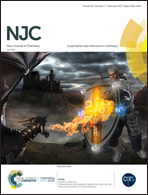New insight into the reaction mechanism of carbon disulfide hydrolysis and the impact of H2S with density functional modeling†
Abstract
The one-step and two-step carbon disulfide hydrolysis reaction mechanisms of CS2 were investigated in this theoretical work using density functional modeling. The results showed that the association interaction between CS2 and H2O results from van der Waals forces. In the first and second steps of two-step hydrolysis, the H atom can easily be captured by the C![[double bond, length as m-dash]](https://www.rsc.org/images/entities/char_e001.gif) S, and C
S, and C![[double bond, length as m-dash]](https://www.rsc.org/images/entities/char_e001.gif) O bonds, respectively. Furthermore, the second step (COS hydrolysis) is the controlling step in the two-step CS2 hydrolysis. During the one-step hydrolysis, the migration of H from H2O to the H–S bond is easier than that to the C
O bonds, respectively. Furthermore, the second step (COS hydrolysis) is the controlling step in the two-step CS2 hydrolysis. During the one-step hydrolysis, the migration of H from H2O to the H–S bond is easier than that to the C![[double bond, length as m-dash]](https://www.rsc.org/images/entities/char_e001.gif) S bond. Meanwhile, the one-step hydrolysis occurs easily without the presence of a catalyst. In addition, the existence of H2S is not conducive to the CS2 hydrolysis; however, H2S is beneficial in maintaining the stability of the intermediates, which results from different interactions such as adsorption and van der Waals forces. The restriction effect for H atom migration caused by H2S also leads to the increase in the maximum reaction energy barrier. Herein, the detailed reaction mechanisms were investigated using the all-electron density functional theory (DFT) computational method. As such, this study provides a theoretical insight for future application and development.
S bond. Meanwhile, the one-step hydrolysis occurs easily without the presence of a catalyst. In addition, the existence of H2S is not conducive to the CS2 hydrolysis; however, H2S is beneficial in maintaining the stability of the intermediates, which results from different interactions such as adsorption and van der Waals forces. The restriction effect for H atom migration caused by H2S also leads to the increase in the maximum reaction energy barrier. Herein, the detailed reaction mechanisms were investigated using the all-electron density functional theory (DFT) computational method. As such, this study provides a theoretical insight for future application and development.



 Please wait while we load your content...
Please wait while we load your content...